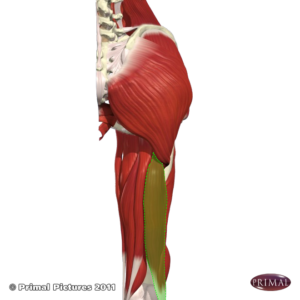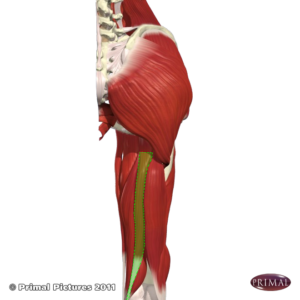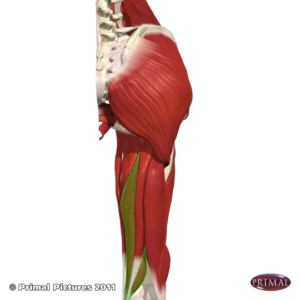By Susi Hately, B.Sc. Kinesiology
I do find the Hamstrings such an interesting muscle group. They get so much blame – for creating back pain, limiting one’s ability to forward bend, and curtailing the desire and capacity to be as swift as the wind when running or cycling. The way I hear people talk about their hamstrings, it is almost as if they are saying …. if their hamstrings could only release “life would be so grand”.
Well, I am here to open up the doors of a grand life and breathe new vigour into your hamstrings, and all that supple hamstrings can provide!
Most people know where the three hamstrings reside connecting the pelvis to the femur and lower leg. Here is a little more detail:
- the biceps femoris’ two heads attach to the ischial tuberosity and the linea aspera respectively then merge together, attaching its distal end to the head of the fibula.

- the semitendinosus attaches to the ischial tuberosity (sharing tendon with the biceps femoris), and onto the upper shaft of the tibia.

- the semimembranosus attaches just in front of the semitendinosus on the ischial tuberosity and has five distal attachment points (not all are seen in the photo below – they are too deep), with the primary attachment being on the on the posterior portion of tibia’s medial condyle, a second attachment interweaving with the popliteal fascia and the remainder joining the tibial collateral ligament of the joint and the fascia of the leg.

Much like my earlier post on the piriformis (http://bit.ly/2bTXlSD), it is easy to blame the hamstrings for feeling tight and limited and for being the primary culprit for why issues are arising in one’s body. In truth, it isn’t hamstrings fault. They are actually responding the environment or neighbourhood in which they reside. When the body isn’t functioning well, something tightens in an attempt to hold you all together so that you can continue to do what you want to do. It is a classic case of compensation which is a good thing. It enables us to the live the life we want to live. The only downside with compensation is that the neuromuscular patterns which are attempting to do actions and movements they aren’t designed to do will at some point become fatigued. There is only so long a compensation can keep it up. Ultimately if we want to feel great with our hamstrings, we need to clean up compensatory strategies.
Let’s take a look at some examples.
- Back Pain/SI Joint Pain. This is a biggie. Yes, it is well known that there is a relationship between short or locked-long hamstrings and back pain, and in some cases SI joint pain. However, what is less known is that “stretching out” the hamstrings can lead to more issues. In many cases the hamstrings are compensating as a stability strategy (albeit a poor one), and if you directly attempt to release them you will pull that holding pattern away. Not a good idea. A more successful strategy would be to improve the movement and relationships of the spine-pelvis-femur-to foot, the suppleness of your rib cage and breathing. See more below.
- Limitations in Hip Rotation. Another biggie. Limitations in hip rotation can limit flexion of the femur. Added to this is that some limitations in hip rotation can also be related to pronation of the feet which can create that inward collapse of the legs and limit hip flexion.
- Limitations of Ankle Mobility and Calf Suppleness. I see this pattern quite a bit. When the outer hip muscles aren’t functioning well, people will often overuse the peroneus muscles on the outer calf. This can also result in (or be a result of) poor ankle function, which is related to shortness in the gastrocnemius and soleus. When we can sort out the lower chain, the hamstrings become much happier – surprisingly quickly.
So now what?
Sometimes people can get confused when I say to improve relationships of the parts, as I did above in point 1. Many want an exercise and a focus on a particular muscle. The point is that there isn’t one muscle, or even two that are to blame, and when we focus on just a muscle then we miss a whole host of other factors that, if considered, would actually make the healing process much faster.
Allow your vision to go more global than the hamstrings themselves. To see the hamstrings in relationship to other parts, look at what they are attached to. What segments, or bones are they moving, and when you do move, are you moving purely or with compensation? If you are compensating, what is actually doing that compensating, and can you quiet that compensation down?
Yes, I will admit that this this takes much more of awareness up front – it isn’t as easy as rolling on a ball or smashing your tissue with a shredding tool. I can tell you that it will pay off for you in huge dividends in very short order if you take the time to become aware. You will develop a very steady foundation which will create greater strength and suppleness. You’ll also have a much greater kinesthetic sense of your inner world and better able to sense when you are overdoing it.
Here are some more specific things to consider:
- Hamstring releasing. When you are practicing positions like “supine hamstring release” also known in yoga as supta padagustasana be sure that you are actually moving your femur in the hip socket and the pelvis is quiet. Be sure that you aren’t arching your back, or sticking your ribs out, or anteriorly/posteriorly tilting your pelvis when you don’t need to. Allow your breath to be easy.
- Improve your hip mobility and stability and the connection to your feet. Take a look at the videos below to give you a sense of what I mean. You don’t need to dig into the hips specifically rather improve the overall coordination between the spine, pelvis, legs, ankles and feet.
- Pay attention to your pelvic floor. I didn’t mention it above, but do consider how you hold your pelvic floor. It isn’t uncommon for people to release a tightly held pelvic floor to experience more suppleness in their hamstrings. I have a short video on orifice breathing below for you to explore.
- Be aware of your rib cage as you move. Notice if you are holding your breath or bracing through you rib cage, holding your ribs down as you lift your arms. You want your rib cage to be still and quiet, not held and hard. There is a video that shares more below.
Remember, the legs are part of the foundation which enables you to stand, sit, walk, run, climb, hike, etc. When they are functioning well and in coordination with the pelvis-spine-rib cage, you will experience a feeling of functional synergy – that state of being that feels taller, lighter, and younger.
Here is the final bumper sticker – that yucky, heavy feeling of tightness, “heldness”, bracing against collapse or that sunken feeling of collapse, can be resolved and changed. Your hamstrings can indeed feel great.
Enjoy the videos, and have a great time exploring,
Susi
ps. October is a month of I Love Anatomy, my foundational online functional anatomy, biomechanics and kinesiology program designed for yoga teachers. A perfect place to dig into these concepts and really grow your skill, your competence and confidence. Playback Quality : High Playback Quality : High Playback Quality : High
With this video you can explore the movement of the hip, knee and ankle.
With this video you can explore orifice breathing.
With this final video is exploring the rib cage.
Enjoy,
Susi
